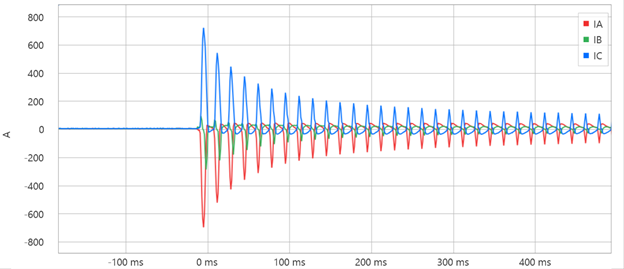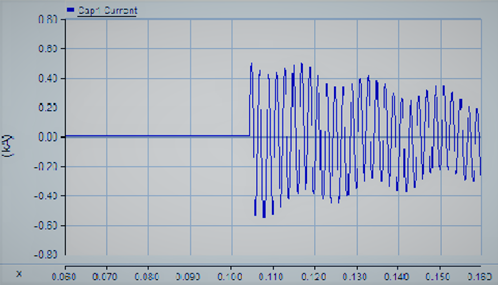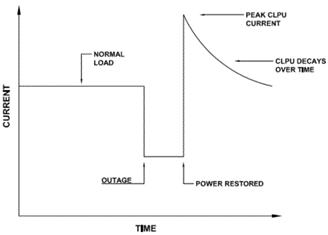When power distribution circuit is re-energized following an extended power outage, new power demand can be higher than pre-outage power demand. This new current demand is known as cold load pickup current. Cold load current occurs when power is lost for a duration for any ‘storage’ type loads such as heating, cooling, pumping, batteries etc. Under normal conditions only fraction of this load will be active at any given time. When power is restored after an extended outage, most if not all of these storage type loads will draw current simultaneously as the heterogeneity of appliances and diversity of customer behavior is lost.

Figure 1 shows actual measurement of an industrial distribution circuit. Pre-outage load is around 100KW. RMS Voltage is shown by gray dotted line. After the outage, power is restored after 10s which results in steep increase in load (Cold Load Pickup Current) to 732KW which is 7.32 times pre-fault load. The increased load returns to nominal value in about 23s. It is estimated that most of the CLPU current is due to inrush of downstream loads (transformers, motors etc.). We can make that conclusion since the outage duration of 10s is too short for thermal loads to change state. This is also reflected in the quick return of load to nominal in 23s. If the outage was of longer duration, CLPU will take much longer time to ‘settle down’ to nominal load.
![Example of actual cold load pickup [CLPU] profile after power loss](https://voltage-disturbance.com/wp-content/uploads/2022/10/Example-of-actual-cold-load-pickup-CLPU-profile-after-power-loss.png)
Feeders with high concentration of storage type loads (heating, cooling, pumping etc.) can create serious cold load pickup current that can lead to accelerated transformer aging, overloading, and voltage drop. Cold load pickup (CLPU) current can also lead to restoration failure as the protective relays can nuisance trip trying to pick this load as the new (increased) load may appear as overload condition to the relay. Cold load pickup makes fault detection on distribution lines challenging. CLPU can continue from several minutes to several hours depending on the duration of outage and nature of loads. Important parameters that determine cold load pickup (CLPU) magnitude and duration are:
- Outage duration: Longer the outage duration, generally more severe CLPU.
- Type of load: Type of load: lighting load, motor load, heating load etc. effects CLPU.
- Time of day: Load varies with time of day and hence CLPU.
- Weather: Extreme temperature can cause severe and long duration CLPU.
- Load level: CLPU is dependent on the pre-outage load level.
Cold load pickup current results from combination of two conditions:
- Inrush current
- Loss of load diversity
1) Cold Load Current due to Inrush Current
Different types of inrush current that contribute towards cold load pickup are listed below.
Magnetizing inrush current: Immediately following power restoration, transformers connected to line will draw magnetizing inrush current which could be 6-12 times full load current lasting for many cycles. Refer to this article on transformer inrush current for discussion on this phenomenon. In a distribution circuit, hundreds of transformers could be connected, and the sum of inrush current can cause nuisance trip of protective device.

Capacitive transient current: Capacitors connected to the circuit will also draw inrush current. Capacitive inrush current can exhibit high peak, but the duration will be very less (usually in microseconds or milliseconds). See capacitor switching transients.

Load Inrush current: Load inrush current is the inrush current that flows when motors start, incandescent lamp filaments are starting to heat up, arc lamps are starting etc.

2) Cold Load Current due to loss of load diversity
When power is restored following an extended outage, connected loads may all try to turn on at the same time. During normal circumstances, loads will be switched on and off randomly based on the temperature/pressure/other set point. After extended power outage, temperature/pressure/other set points are likely to have drifted from the set value and hence equipment such as motors, pumps, compressors will all try to start at the same time across the entire distribution line. This could lead to cold load pickup overload condition.
A relatable example of loss of diversity is residential air conditioning (AC) units. Under normal circumstance each AC unit may turn on and off at random times whereas after an extended power outage, temperature at each residential unit may have drifted away from set point causing all units trying to start at the same time upon restoration of power. This is known as loss of load diversity.
Small residential motors and loads do not require manual intervention to restart whereas large industrial motors and loads usually require manual reset. For this reason, cold load pickup calculations generally do not include large industrial motor starting.
Predicting cold load pickup current

Predicting cold load pickup current (CLPU) is important for restoration of power after an extended outage. Prediction of CLPU help to understand the dynamic behavior of reconnection on frequency control of rotating generation machines. Prediction of CLPU is also required to assess power flow between various points on the grid and to assess the maximum thermal loading of connected distribution equipment. Though accurate calculation of cold load pickup current is not practical, various approximations has been made such as delayed exponential model [Ref 3] and various physical models [Ref 1-2]. Physical models rely on heating and cooling, temperature, other similar information. Readers are encouraged to visit the cited articles if interested in the topic of modelling CLPU.
Figure 5 shows exponential approximation model for CLPU. Exponential decay model provides good fit to measurements and also mimics the behavior that is expected from physical effects such as heating, cooling etc. CLPU curve after power restoration is given by [Ref 3]:

An example of exponentially decaying CLPU curve is shown in figure 5. Note the close correlation between the figure 5 and the actual measured CLPU in figure 1.
Transformer Current Calculator
References
- Lang, W.W., Anderson, M.D., Fannin, D.R.: ‘An analytical method for quantifying the electrical space heating component of a cold load pickup’, IEEE Power Eng. Rev., 1981, ER-2, (4), pp. 38– 38
- Schneider, K.P., Sortomme, E., Venkata, S.S., et al.: ‘Evaluating the magnitude and duration of cold load pick-up on residential distribution using multi-state load models’, IEEE Trans. Power Syst., 2016, 31, (5), pp. 3765– 3774
- Cold load pickup model parameters based on measurements in distribution systems, Christian Hachmann,Gustav Lammert,Lucas Hamann,Martin Braun, The institution of engineering and technology.
